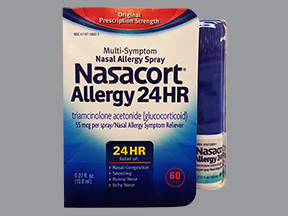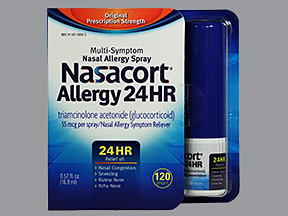TRIAMCINOLONE ACETONIDE - NASAL
PHONETIC PRONUNCIATION: (tri-am-SIN-oh-lone uh-SET-oh-nide)
COMMON BRAND NAME(S): Nasacort
GENERIC NAME(S): triamcinolone acetonide
Uses
USES: Triamcinolone is used to prevent and treat seasonal and year-round allergy symptoms (such as stuffy/runny nose, itchy eyes/nose/throat, sneezing). Triamcinolone belongs to a class of drugs known as corticosteroids. It works by reducing swelling (inflammation) in the nasal passages. Check the ingredients on the label even if you have used the product before. The manufacturer may have changed the ingredients. Also, products with similar names may contain different ingredients meant for different purposes. Taking the wrong product could harm you.
How to use TRIAMCINOLONE ACETONIDE - NASAL
HOW TO USE: If you are taking the over-the-counter product to self-treat, read and follow all directions on the product package before taking this medication. If you have any questions, consult your pharmacist. If your doctor has prescribed this medication, take it as directed. Read the Patient Information Leaflet provided by your pharmacist before you start using this medication and each time you get a refill. Follow the illustrated directions for the proper use of this medication. If you have any questions, ask your doctor or pharmacist. This medication is for use in the nose. In adults, the usual dose is 2 sprays in each nostril once or twice a day or as directed by your doctor. In children, the usual dose is 1 to 2 sprays in each nostril once daily or as directed by the doctor. Avoid spraying this medication in your eyes or mouth. Gently blow your nose before using this drug. Shake the spray device well before each use. Follow the package instructions to properly prime the spray. Remove the protective cap before using the spray. Close one nostril by pressing it with your finger. Tilt your head as directed and carefully insert the nasal applicator into the other nostril. Press down firmly on the device to deliver the prescribed number of sprays. Do not spray directly onto the middle wall of your nose (nasal septum). Breathe in gently through your nose and out through your mouth. Repeat in the other nostril. Replace the cap on the nasal inhaler. Avoid blowing your nose for 15 minutes after using this medication. Dosage is based on your medical condition and response to treatment. Younger children may need a smaller dose and help from an adult to use this medication properly. Use this medication regularly in order to get the most benefit from it. To help you remember, use it at the same time(s) each day. Do not increase your dose or use it more frequently than directed. This medication does not work right away. Some people will feel this medication working within 1 day, but it may take up to 1 week before the full benefit of this drug takes effect. Ask your doctor or pharmacist if you should also use other medications (such as nose drops/spray, allergy drugs taken by mouth) along with this drug until it takes full effect. Keep track of the number of sprays used from the device. Discard the device after you have used the number of sprays specified on the manufacturer's package. Do not pour any remaining medication into another container. Follow the package instructions to unblock or to clean the spray device. If your condition persists or worsens, or if you think you may have a serious medical problem, get medical help right away.
Side Effects
Precautions
Interactions
Overdose
Images
Reviews
Disclaimer
IMPORTANT: HOW TO USE THIS INFORMATION: This is a summary and does NOT have all possible information about this product. This information does not assure that this product is safe, effective, or appropriate for you. This information is not individual medical advice and does not substitute for the advice of your health care professional. Always ask your health care professional for complete information about this product and your specific health needs.





No Reviews Yet